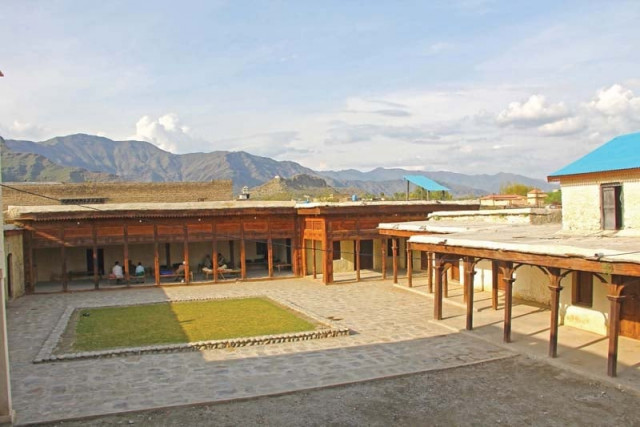Shamozai hujra: The tie that binds Chungi Zara’s residents
Elders, youth gather every evening to discuss a range of matters.

Shamozai Community Hujra in Chungi Zara Khel village of Barikot tehsil has towered strong over both joy and grief. PHOTO: FAZAL KHALIQ/EXPRESS
Built over a century ago, Shamozai Community Hujra has stood the test of time. The passing years have done little to reduce its significance for the residents of Chungi Zara Khel village of Barikot tehsil in Swat. A double-storey structure with 17 rooms flanked by a courtyard – it is believed to be the largest hujra in the area, built before the formation of the princely state in 1917.
Over the years, Shamozai Community Hujra has not only served as a guesthouse for travellers from far and wide but has also witnessed the highs and lows of village life. It has stood proud during celebrations and offered a sturdy familiarity in times of mourning, towering strong over both joy and grief.

Shamozai Community Hujra in Chungi Zara Khel village of Barikot tehsil has towered strong over both joy and grief. PHOTO: FAZAL KHALIQ/EXPRESS
Unlike most old buildings which serve as a reminder of the past, it has become an active part of everyday life of Chungi Zara Khel residents. As a result, the hujra was recently renovated and conserved by Prince Claus Fund for Culture and Development, Netherlands in collaboration with Swat Participatory Council (SPC).
If walls had ears
Although residents cannot quite pinpoint an exact date when the hujra was constructed, there is a consensus it was built before the formation of the Princely State of Swat.
Some also believe the premises were once used as a sub-jail. Mohammad Shafiq, an elder of the area, said the building served multiple purposes for the Swat State. “The upper storey of the hujra was used by the ruler,” he said. “One of the rulers also used to settle disputes during his stay there.”
“Our forefathers built the hujra to accommodate guests who came from far and wide,” Abdul Waris, one of the guardians of the hujra told The Express Tribune. “People used to stay here and our forefathers considered it an honour. The fact that it is still used by people is also quite an honour.”

Shamozai Community Hujra in Chungi Zara Khel village of Barikot tehsil has towered strong over both joy and grief. PHOTO: FAZAL KHALIQ/EXPRESS
In his book titled The North-West Frontier, Dr Sultan-i-Rome, a historian, claims no one can claim sole ownership over a hujra. On the contrary, it is considered to be the communal property of the people of the village it is situated in. This purpose has been well-served by Shamozai Community Hujra.
According to Waris, residents still gather at the hujra every evening to discuss a range of matters.
Young people in the area also visit the hujra with their elders to learn about their social and cultural values. “Every evening we come and spend time with our elders at the hujra,” said Sohail Ahmad. “We listen to the discussions and get to learn a lot about our culture and values. The hujra is like an institution for us.”
The hujra also has an area where the deceased can be bathed, a facility which is availed when someone dies in the village.
Deeply rooted
Even though it was built using a combination of stone, timber and mud, it remains a sturdy structure which is capable of withstanding earthquakes and other natural disasters. The building has been maintained over the years and is typical of Swat architecture.
“With its wooden frames, stone masonry and patterned woodwork, the hujra is one of the best examples of traditional Pukhtun [architecture],” says SPC Executive Director Mohammad Roshan.
While significant investment has been made to keep Shamozai Community Hujra well-maintained, in many ways the hujra returns the favour by contributing to the well-being of the society it hosts.
Published in The Express Tribune, April 1st, 2015.













COMMENTS
Comments are moderated and generally will be posted if they are on-topic and not abusive.
For more information, please see our Comments FAQ